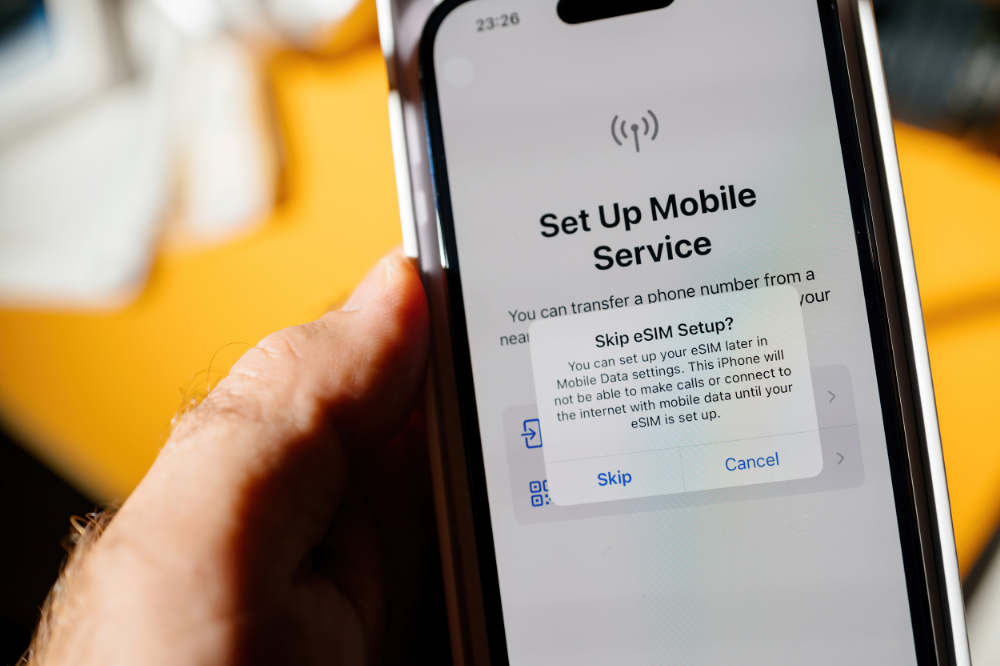
Japan Travel SIM Card: How to Choose the Best Option
Staying connected while traveling in Japan is essential for navigating unfamiliar cities, accessing real-time translation, and staying in touch with loved ones.
Japan offers some free WiFi hotspots in hotels and public places, which are sometimes unreliable and difficult to access. International roaming is another option, but it often comes with high fees and limited data.
While securing a connectivity solution before arriving is best, knowing which one to choose can be daunting. In this article, we’ll explore your connectivity options, from SIM cards to pocket WiFi, so you can explore Japan with peace of mind.
Choosing the Best Japan Travel SIM Card for Your Trip
With multiple options available, from prepaid SIMs to eSIMs, it’s essential to understand SIM cards’ features before deciding.
Types of SIM Cards for Japan Travel
Staying connected in Japan starts with choosing the right SIM card for your needs. There are several options available, each catering to different travel styles and requirements:
- ●Prepaid SIM Cards
- Prepaid SIM cards are the most common option for short-term visitors. They come with a fixed data allowance and can be used for a set number of days.
- Activation is usually straightforward—simply insert the SIM into your phone, follow the instructions to configure the APN settings, and start using data. These SIMs are widely available at airports, electronics stores, and even vending machines in Japan.
- ●Data-Only SIM Cards
- Data-only SIMs are an excellent choice for travelers who don’t need to make calls or send SMS messages. They provide Internet access without a phone number, making them ideal for navigation apps, social media, and messaging services like WhatsApp or LINE.
- They often come in prepaid packages with different data limits, such as 3GB, 5GB, or unlimited options.
- ●eSIMs
- If your smartphone supports eSIM technology, eSIMs are one of the most convenient options. eSIMs allow you to download a digital SIM profile onto your device without needing a physical card.
- They can be activated instantly upon arrival in Japan, eliminating the need to visit a store or pick up a SIM. However, not all devices support eSIMs, so checking compatibility beforehand is essential.
-
How to Check Phone Compatibility
-
Before purchasing a Japan travel SIM card, you must ensure your phone can support it. Here’s how:
- Unlocked vs. Locked Phones:
- Your phone must be unlocked to use a foreign SIM card. Many carriers lock their devices, restricting them to their network. Contact your carrier before departure to confirm if your phone is unlocked or request an unlock if necessary.
- eSIM Compatibility:
- If you’re considering an eSIM, ensure your phone supports this feature. Popular models that include eSIM support are the latest iPhones, Google Pixel devices, and some Samsung Galaxy models. You can verify compatibility in your phone’s settings or on the manufacturer’s website.
-
By selecting the right SIM card and confirming your phone’s compatibility, you’ll have seamless Internet access throughout your trip, making your travel experience in Japan smoother and more enjoyable.
-
Comparing Connectivity Options: Finding the Best Solution for You

Choosing between a SIM card, eSIM, or pocket WiFi depends on your budget, travel style, and data needs. Here’s a breakdown to help you decide.
Cost and Data Plan Comparison
Japan Travel: SIM Card or Pocket WiFi?
Prepaid SIMs, eSIMs, and pocket WiFi have different pricing and benefits. For example, NINJA WiFi offers a variety of plans to suit various needs, among which you’ll find:
- ●SIM Card Plans: 1GB/1 day for 7 days at 3,795 yen; Infinite Unlimited Plan for 15 days at 7,150 yen.
- ●eSIM Plans: A 5GB plan for 5 days costs 3,102 yen, and a 30 GB plan for 15 days costs 7,557 yen.
- ●Pocket WiFi Plans: Unlimited Plan (Softbank): 3GB/1 day for 770 yen per day; 5G Unlimited Plan: 2,200 yen per day.
If you’re visiting Japan for an extended period, pocket WiFi with unlimited data might be the most cost-effective option, especially if you share it with family or friends.
Japan Travel: SIM Card or Pocket WiFi?
The best choice depends on your travel style and data-sharing needs. Solo travelers may find SIM cards or eSIMs more convenient since they don’t require carrying an extra device. However, groups traveling together benefit from pocket WiFi, which supports multiple devices and allows everyone to have connectivity.
Ease of use is essential when choosing between a SIM card, eSIM, or pocket WiFi. While SIM cards and eSIMs require some setup—such as inserting the SIM, adjusting APN settings, or scanning a QR code for activation—pocket WiFi is a straightforward plug-and-play device.
Once powered on, it instantly provides a secure and stable connection, making it a hassle-free option for travelers who prefer minimal setup. This is especially convenient for those unfamiliar with changing network settings on their phone or who may experience difficulties troubleshooting connectivity issues.
Coverage and connectivity also play a key role in deciding between these options. SIM cards rely on your phone’s built-in reception capabilities, which can be affected by the phone model and its supported network bands.
In urban areas, most SIM cards provide strong LTE coverage, but in rural or mountainous regions, certain network bands are required for better reception. On the other hand, Pocket WiFi often offers stronger and more stable signals as these devices are optimized for connectivity and can switch between networks to maintain performance.
Pocket WiFi may be the more reliable choice for travelers planning to explore beyond significant cities.
A stress-free travel experience is a significant consideration. Both SIM cards and pocket WiFi provide reliable access to maps, translation apps, and social media, ensuring you’re never lost or disconnected.
Additionally, relying on a SIM card or pocket WiFi provides a secure internet connection, eliminating the risks associated with public WiFi networks, which can be vulnerable to cyber threats.
For convenience, NINJA WiFi offers easy pickup and return locations at major airports, city center locations, and even through delivery services. Pickup flexibility implies that you can use your device as soon as you land and return it to a different location before departure.
-
Essential Tips for Getting a Japan Travel SIM Card

Making the right choice when purchasing a Japan travel SIM card can save you time and money during your trip. To ensure a smooth experience, there are several key factors to consider:
Book Ahead for Peace of Mind
Ordering a SIM card before your trip ensures availability and saves you from the hassle of searching for one upon arrival. Many travelers assume they can easily buy a SIM card at the airport, but popular options may sell out, and kiosks have limited stock, especially during peak travel seasons.
Online purchases allow you to choose the best plan for your needs and have the SIM card shipped to your home, hotel, or pickup location at the airport. Therefore, you can start using mobile data as soon as you land without delay.
Consider Your Data Needs
Choosing the right data plan is crucial to avoid running out of data mid-trip or paying for more than you need. A lower data allowance may suffice if you primarily use Google Maps, messaging apps, and web browsing.
However, if you plan to stream videos, upload photos frequently, or make long calls through WhatsApp or Messenger, consider a plan with a higher data limit or unlimited usage.
For example, if you’re staying for two weeks and expect heavy data use, an unlimited SIM card or pocket WiFi could be the best option to ensure uninterrupted connectivity.
Know Where to Buy and Pick Up Your SIM Card
While SIM cards are available at airports, electronics stores, and convenience stores, availability varies, and pricing may be higher for last-minute purchases. Electronics stores like Bic Camera and Yodobashi Camera often offer multiple brands and plans, but the purchasing process may take longer due to registration requirements.
Pre-ordering online ensures a seamless experience, with airport pickup or hotel delivery options that allow you to install the SIM card and activate it immediately upon arrival.
Set Up Your SIM Card Immediately
Set up your SIM card as soon as you arrive in Japan to avoid any connectivity issues. Insert the SIM and configure the APN settings following the provided instructions.
The process typically takes just a few minutes but is best done at the airport, where customer support may be available if troubleshooting is needed. If you need to reactivate the service later, keep a backup of the setup guide or QR code (for eSIM users). By preparing in advance, you’ll ensure a stress-free experience using mobile data throughout your trip.
Conclusion
Reliable internet access is essential for making the most of your time in Japan. Whether you’re using Google Maps to navigate intricate train systems, translating menus at a local izakaya, or planning the next day’s visits, having a dependable connection ensures a smooth journey.
You can avoid unexpected roaming charges and the frustration of unreliable public WiFi by selecting the right connectivity option—whether it’s a prepaid SIM card, eSIM, or pocket WiFi.
For travelers seeking a simple and flexible solution, NINJA WiFi offers a variety of affordable SIM and pocket WiFi plans to suit different needs. With convenient pickup and dropoff locations at ten different airports, staying connected in Japan has never been easier.
Whether traveling solo and needing a quick eSIM activation or exploring with a group that requires unlimited shared data, NINJA WiFi provides a secure internet experience from the moment you arrive.
Don’t leave your connectivity to chance—reserve your NINJA WiFi device or SIM card today and enjoy worry-free travel in Japan!








